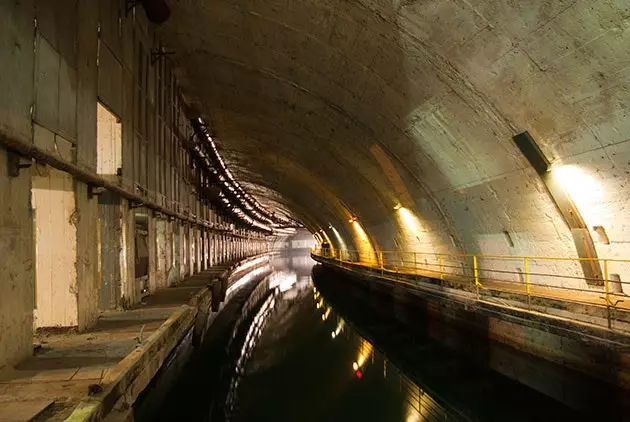
The Balaklava tunnels
The surface of kyiv is teeming with people. These weeks, to protest against President Yanukovych and his dealings with the Russians, to demand a rapprochement with the European Union, thousands of demonstrators take over the squares, launch harangues in the streets, give concerts in the parks, hang blue and starry flags from the necks of the statues, they have even knocked down a statue of Lenin. The police brutally suppress some of the concentrations.
You can't see it on TV, but the subsoil also vibrates . In a crowded subway station, the crowd sings the national anthem until the ceiling lamps tremble; in the corridors the kids distribute leaflets, stickers and flags; in an underpass , some musicians dressed as Cossacks play traditional songs, people gather, dance in a circle around them and end up chanting “revolution, revolution, revolution!”.
In Ukraine, a country whose surface has been swept by bombings, invasions, planned famines, nuclear explosions and - of course - by the cold, there is always a part of life that lurks underground . This subterranean instinct has excavated some of the most fascinating landscapes in the country.
1) BALAKLAVA: THE ATOMIC SUBMARINE BASE INSIDE A MOUNTAIN
A lady waits at the entrance with a serious expression. We give her some bills, we look to the sides of her with suspicion of her and she she then opens a door of ten tons of aluminum and titanium: we can now enter the Object 825 GTS , the code name for the super-secret Balaklava atomic submarine base.
The place gives for fantasies . The submarines of the Soviet Union entered the Balaklava Bay, a kind of narrow and winding fjord, on the Crimean peninsula at night. On one of the banks, invisible from the open sea, was a gigantic camouflaged steel gate. The gate opened and the submarine was sailing into Tavros Mountain , in whose entrails Soviet engineers had excavated a naval base to shelter from spy satellites. A channel 602 meters long crosses the mountain from north to south, from the entrance through the fjord to the exit to the open sea through another camouflaged gate. Fourteen atomic submarines could dock in that channel and its branches. . Inside there are docks, workshops, a dry dock, nuclear torpedo stores, offices, shelters, and an entire underground city that was classified as a first-class atomic shelter: it could withstand a direct blast from a hundred-kiloton nuclear bomb and three thousand people. they could survive a month inside, protected under the granite mountain.
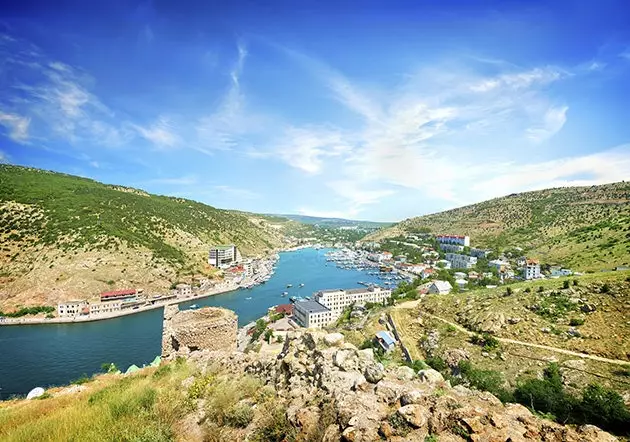
Balaklava Bay
Balaklava disappeared from the maps in 1957 : That year the construction of the underground base began, which lasted four years, and this small fishing village became one of the most secret areas of the Soviet Union. His name was not on any document, no one officially worked there and no one could enter the town, a ban that was in place until 1996 , when the last Russian submarine came out of the mountain.
In 2003 the base became a museum. Now the lady at the entrance opens the steel and titanium doors in exchange for a few bills; a guide leads the groups through the galleries, the canal, the docks, the arsenal; and as the tourists pass by, loudspeakers emit port noises: metal banging, hammering, sawing, screeching, sirens, ominous buzzing that seem to warn of an atomic bombing. In the museum, real segments of submarines are exhibited with their crew dolls on board, photos of dolphins that were tied to mines and those who trained to get close to enemy ships, models, torpedoes, anti-nuclear divers and some very tempting control panels, with their keys, switches and buttons with which to detonate the apocalypse, are exhibited. Among the group of tourists milling around the guide is a Ukrainian army cadet accompanied by his mother, who has come to see him at the nearby Sevastopol base. As the guide speaks, the cadet reaches out and gives a furtive caress to a torpedo.
Practical information. The museum is open from ten to three, except on Mondays, and costs 40 hryvnias (3.6 euros). Balaklava is 18 kilometers from Sevastopol , on the Crimean peninsula. The road cuts through the valley where the British staged the legendary and disastrous Light Brigade charge against Russian troops in 1854. There are memorials among the vineyards and a museum on Sapun Hill.
2) ODESA: THE PARTISAN CATACOMBS
The guide walks quickly through a lighted gallery, makes several curves and stops before a wall on which is read a Russian inscription in block letters. The guide shouts it in several languages, including Spanish:
- Blood for blood, death for death!
It is a graffiti of the soviet partisans who took refuge in these catacombs during the Nazi invasion of Odessa, on the shores of the Black Sea, in 1941.
We are in the town of Nerubaiskoye , ten kilometers from Odessa, inland, but this network of tunnels winds below the surface to the port and the basements of houses in the center of the city. The dimensions of the catacombs are huge and poorly defined. They are spread over three levels, connected by wells and passageways , and the deepest reaches up to 60 meters below sea level. Since the 1960s, various caving clubs have explored and mapped some 1,700 kilometers of tunnels, and the guides point out that the labyrinth measures 2,000 or 2,500 kilometers. Ours belongs to the enthusiasts:
- There are 3,000 kilometers. They are the largest catacombs in the world.
In various areas of these tunnels thirteen soviet resistance groups hid , about eighty or a hundred people each, and only one of them was dismantled by the Nazis. The human moles organized small underground cities, with wells through which they received weapons and food from the outside, and they came out from time to time to attack enemy headquarters by surprise. The Nazis, in turn, tracked them underground with dogs and gassed the tunnels , without much success.
The origin of the tunnels is also diffuse . It seems that the Cossacks, expelled from the Russian empire by Catherine the Great and welcomed on these shores by the Turkish sultan, extracted limestone for their settlements. When the Russians conquered the territory in 1792, they founded the city of Odessa and they delved into these quarries to extract the materials and build the baroque houses and palaces of a thriving city. The labyrinth greatly expanded in the following decades: it was a quarry, a wine warehouse, a smugglers' route... Its most epic days were those of the resistance during World War II.
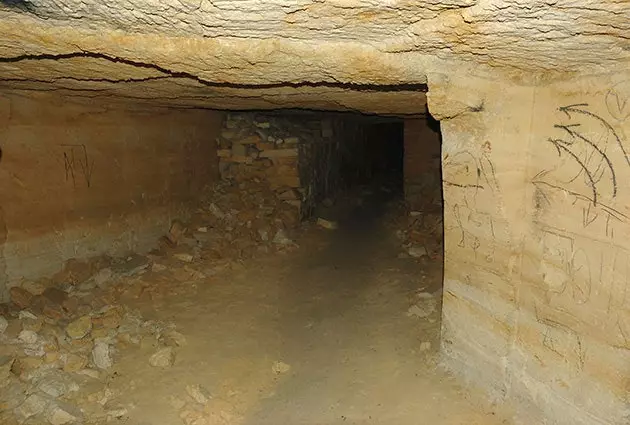
The catacombs of Odessa, refuge of partisans
The guide walks through the tunnels and shows the rooms prepared by the partisans to live underground. There are bedrooms with large platforms dug into the rock, as a bed, covered with straw; there are kitchens with pots and chimneys that rise to the surface; there is a small school with blackboard, desks and books ; there is a hospital with beds and first-aid kits; there are offices with typewriters, telephones, radios, and maps; there is a shooting gallery; there are tables with bombs, rifles, axes and Molotov cocktails, there are Soviet flags, there are caricatures of Hitler on the walls. There are bouquets of flowers in every corner.
This section of the labyrinth is illuminated, the tunnels are wide, but it is advisable not to separate from the guide: when speleologists delve into the catacombs, find rifles, grenades, newspapers from decades ago , coins from the tsarist era and every few years the skull of a smuggler, the mummified corpse of a partisan or the remains of a clueless visitor. In January 2012, a 22-year-old amateur speleologist entered the labyrinth alone and was never heard from again. Three days after his disappearance, rescue teams found his headlamp and his sleeping bag. They found nothing else. On January 1, 2005, a group of young people went down to the catacombs to celebrate the New Year's revelry, a 19-year-old girl was lost and two years later her desiccated body was removed.
In the dry air of the catacombs, mummified corpses, horror stories and general history are preserved. The small museum of Partisan Glory, at the end of the visit, exhibits photos, documents, Soviet posters and a handwritten message from Fidel Castro during his visit in 1981.
Practical information. Vans leave from the Odessa train station for guided tours of the catacombs for 70 hryvnias (6.3 euros). It is difficult to find guides who speak English, but there are . Another option: at the nearby bus station, find out which one goes to Nerubaiskoye and ask the driver to let us know at the catacomb stop. Once there, you have to ask for a guide and haggle over the price of the visit.
3)kyiv: THE DEEPEST METRO STATION ON THE PLANET
Some Kievans get impatient and start walking down, because the escalators take four minutes to descend to the Arsenalna metro station, the deepest in the world. The line crosses a prominent hill, on the bank of the Dnieper River, and in its bowels they built this station, 105 meters below the surface.
Arsenalna it is one of the five stations with which the kyiv metro was opened in 1960, five museums of Stalinist architecture: granite floors, marble columns, ceramic walls, chandeliers, bronze sculptures, busts, bas-reliefs, mosaics with Soviet imagery that was gradually dismantled in the 1990s. The five stations of Vokzalna, Unyversitet, Teatralna, Khreshchatyk and Arsenalna, with their stairs, their galleries and their vestibules, preserve the splendor and the Soviet chill , when we know that another use was contemplated for them: stations as deep as Arsenalna, with their branching passageways, were designated as fallout shelters.
Arsenalna is located on the same hill where kyiv's great underground scene was excavated: Pechersk Lavra, the cave monastery.
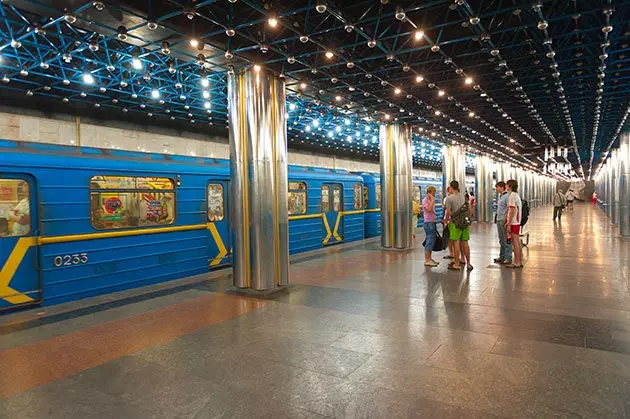
The kyiv metro is home to the deepest stations in the world
4)kyiv. PECHERSK LAVRA: TO KISS MUMMIES
Be careful because some tend to get dizzy. At the entrance to the Pechersk Lavra, the cave monastery, they force you to buy a candle to light the way and they give precise instructions to carry it: trapped between the fingers, with the hand extended as a candlestick, so that the wax drips do not leave the floor greasy. It's not nonsense: more than 200,000 pilgrims descend every year into these extremely narrow tunnels , oppressive, in which hundreds of mummified saints and monks are lined up. And below there are bearded priests who scold those who carry the candle badly.
They open the door for us, we go down the stairs and a vapor envelops us in which the flames of the pilgrims fade and in which the a whiff of incense perhaps mixed with coffin shavings and pope's beard . From here our freedom of maneuver almost disappears, especially on holidays and during mystical peak hours: we follow the line of pilgrims that advance through a vaulted gallery, so low that sometimes you have to duck your head to avoid bumping your head, and so narrow that we must walk with our arms glued to our ribs. The pilgrims drag their feet through the labyrinth that twists, forks and folds, only whispers, murmurs, the chanting of women singing hypnotic chants are heard. Every few meters a hole opens in the wall: just enough space for a glass urn, in which the incorrupt body of a monk or a saint rests . They are mummies completely wrapped in blankets with embroidery and rhinestones. Some show their parched, woody, violet trotters.
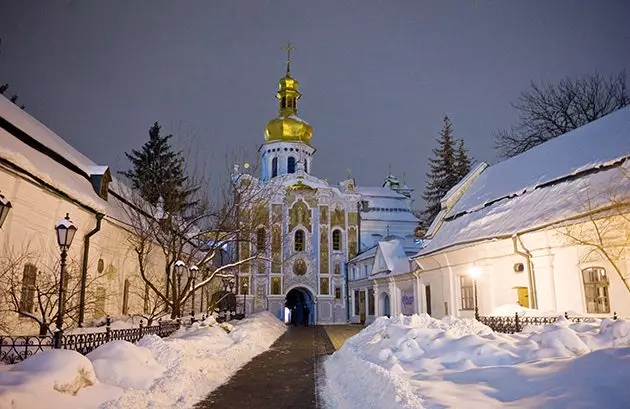
Pechersk Lavra and its underground world
Pilgrims can walk five hundred meters of labyrinth. The rest of the tunnels (which they say go as far as Moscow: wow!) are only accessible by monks and archaeologists . Plugs are sometimes formed, when women in headscarves kneel and kiss urns, under votive lamps, icons of saints, and signs reporting the name of the deceased and the century in which he lived. The mummy meeting is select : around here lie Alipio the Venerable, icon painter; Nestor, the first Slavic chronicler; Saint Spyridion, patron saint of potters; a Grand Duke of Lithuania, a Prince of kyiv; and also, apparently, other relics such as the head of Clement I, the fourth pope in history; the body of Yuri the Long-Armed, founder of Moscow, and even the remains of Ilya Muromets, the gigantic hero of the first Russian epics, who fought Tartars and monsters, who brought down the bell towers of kyiv when Prince Vladimir forgot invite him to a party and that he ended up canonized for his defense of the homeland and the Orthodox faith.
This case of Ilya Muromets, 12th-century superhero, legendary knight of the medieval Kievan Rus state, shows that the Pechersk Lavra caves are not just a religious center: they also constitute the core of Ukrainian history, the testimony of the millenary persistence of the country . Exactly a thousand years ago, in 1013, a Greek monk named Antony came to kyiv to spread Christianity and settled in a grotto on the banks of the Dnieper River. His disciples dug more caves and tunnels on that hill, to settle underground and lead an ascetic life, and soon raised the first wooden monastery on the surface.
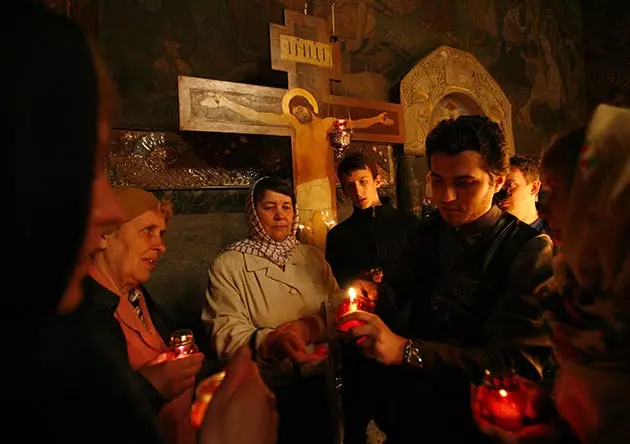
Pilgrims in Pechersk Lavra
The complex grew over the centuries and with the support of the princes of kyiv, until it became a kind of orthodox Vatican : Within a 28-hectare walled enclosure, white cathedrals, churches and monasteries rise, crowned by green roofs and golden domes. Schools of chroniclers and icon painters were born here, the first printing press in the country was established here, here the heart of Slavic and Orthodox culture beat for centuries. The set of monasteries, declared a World Heritage Site, was invaded, looted and burned by the Cumans, the Mongols, the Tatars, the Russians, the Nazis, the Soviets . That is why the persistence of the underground monks is a source of national pride and the origin of a thousand legends: they say that the incorruptibility of the saints is miraculous, they say that the Soviets piled the mummies on a truck to take them away but the engine refused to start until They put them back in their place They say that the corpses emit an energy that neutralized the Chernobyl radiation.
Underground, the pilgrims kiss the showcases , a priest celebrates mass in a chapel packed with seven people, a monk comes out of his cell and scolds the tourist who no longer has the candle trapped between the fingers of his open hand.
Practical information. From the Arsenalna metro station, the bus and the tram go up to the entrance of the Pechersk Lavra. Very expensive tickets for tourists and for taking photos are sold at the ticket offices: they are not necessary. To enter the complex of monasteries, it is enough to pay the minimum pass: 3 hryvnias (0.27 euros). The visit to the caves is free, you just have to buy the candle.
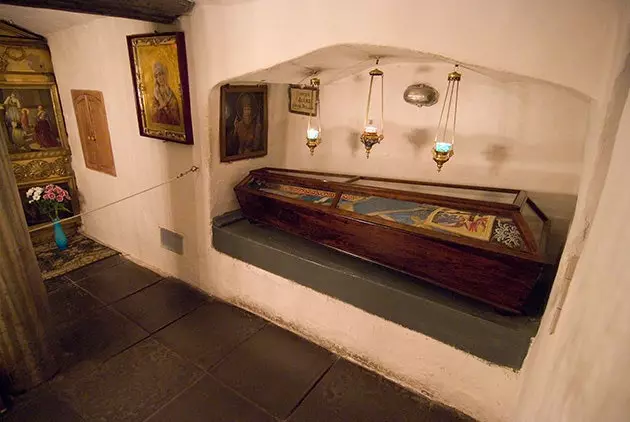
Gathering of mummies underground
5) CHERNOBYL. THE BURIED EARTH
One of the strangest tasks in the weeks after the explosion at the Chernobyl nuclear power plant on April 26, 1986, was to bury the earth . Groups of soldiers dedicated themselves to removing the upper layers of the most radioactive areas, to bury them in deep pits that were later covered with concrete. The land thus stripped was covered with dolomite sand. A lunar landscape remained.
They buried houses, cars, slaughtered animals, they buried even the trees . They cut down the famous Red Forest of Chernobyl, named for the splendor that the pines took on due to radiation, buried the trunks far from there and planted new pine and eucalyptus trees in the area. Now they grow normally, although they accumulate high doses of radiation.
Vasili Kovalchuk, 55, was one of the Chernobyl liquidators . A few hours after the catastrophe, he was put to carry bales of sand for helicopters to drop on the gutted reactor. He then dedicated himself to cleaning the radiation from the vehicles that were used on those emergency days. He worked in the area from April 26 to May 8. At the time he suffered an osteoma -a benign bone tumor-, pancreatitis, gastritis, chronic digestive diseases, and at the age of 40 they retired him and gave him a disability pension of 220 euros per month and some discounts on bills. He says that he once tried to get close to Korogod, his abandoned hometown, 14 kilometers from the reactor, but he is already lost in the brush.
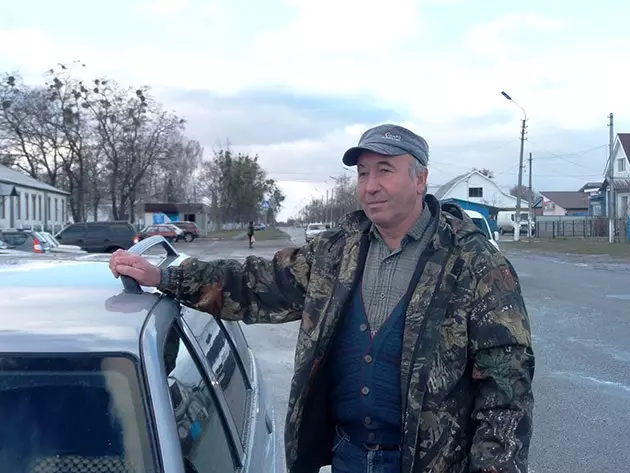
Vasili Kovalchuk, one of the liquidators of Chernobyl
Thanks to the work of liquidators like him, today it is not so dangerous to get close to Chernobyl's number four reactor. Around the plant they renewed the land, poured concrete and new asphalt , so the soil is not so polluted. The poison is still in the air, of course: the counters register radiation figures tens of times higher than normal, but that allow limited stays in the area without the accumulation being excessive.
In fact, there are hundreds of workers working a few meters from the plant. They are building a gigantic dome to cover the reactor , because inside it still keeps 80 tons of nuclear fuel and 70,000 tons of other highly polluting substances, and the current sarcophagus already has cracks and radioactive leaks. The new dome, made of steel and concrete, is 105 meters high, 150 meters long and 260 meters wide. When it is finished, at the end of 2015, it will be moved on rails and placed on top of reactor number four.
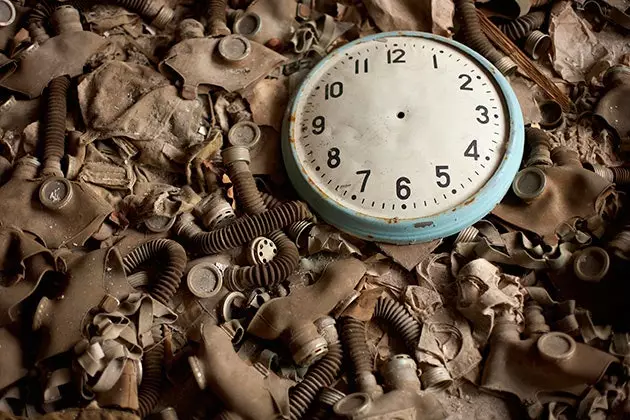
Remains of a clock in Pripyat
The workers work a limited number of hours, measure the radiation doses received and they have to spend fifteen days a month outside the exclusion zone (a radius of thirty kilometers around the plant) . That yes: it exists a picaresque between comic and terrifying . From workers who seek the most radioactive points in the area to spend a few minutes there, exceed the maximum dose and thus get rid of work, to bosses who force the employees of the dining room to reset their counters to zero so as not to have to remove them from the area. early.
For visitors the danger is low: in a guided itinerary of six or seven hours through the area, the accumulated radiation is equivalent to that received on a transoceanic flight or in any city for a few days.
For locals Chernobyl will be an eternal problem: "We don't know what to do with the nuclear waste left in the reactor," says Kovalchuk. "We don't know what to do with the millions of cubic meters of radioactive soil." "We expected them to explain the thing to us on television," says an anonymous inhabitant of the area in Voices from Chernobyl, the shocking book by Svetlana Alexievich. “We hoped they would tell us how to save ourselves . Instead, the worms burrowed very deep into the ground, going half a meter and up to a meter deep. We didn't understand anything. We dug and dug and didn't find a worm for fishing. The worms and the beetles disappeared”.
Practical information. To enter the Chernobyl exclusion zone permission is needed . In kyiv there are many agencies that organize one-day visits, in small groups, with prices around 120 euros. You have to reserve them days in advance, to do the paperwork. The vast Chernobyl nuclear complex is often visited, the plant that burst, the new sarcophagus, the Chernobyl village where the workers now live, some abandoned houses in the forest and the ghost town of Pripyat.
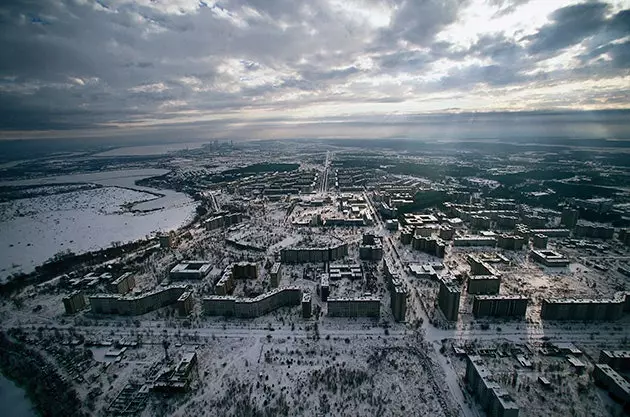
Aerial view of the ghost town of Pripyat
